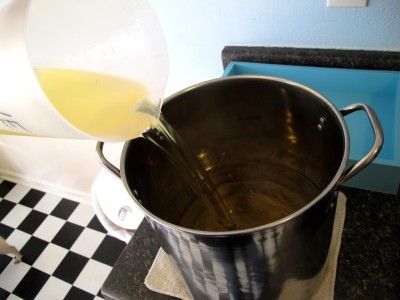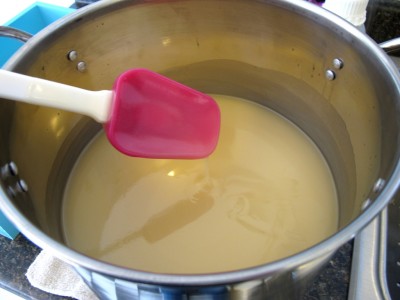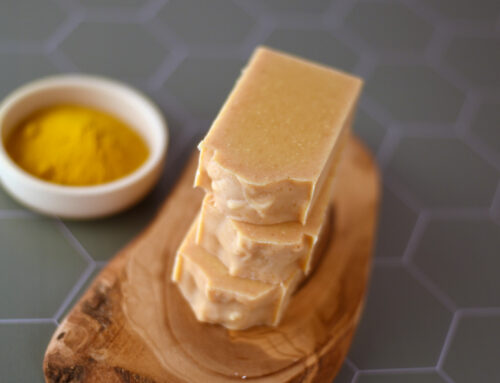It seems like I haven’t blogged in forever! The last month was absolutely, crazy, insanely busy. I was out of town several weekends. First to Haiti to check on the progress of OFEDA. They are doing remarkably well and were making all kinds of soap. (More on that later.)
After that was Kansas to teach at the first ever Central Soapers Workshop. This was an awesome conference! Then I went to New York to teach with Holly Port and Marla Bosworth for Soap University. So much fun! I’ll be writing about some of these trips later…but for now I want to share a few things.
I’ll be teaching silicone mold making at the HSMG Conference this year in Raleigh. Originally I was going to teach simple single cavity molds but I think most people really want to learn how to make the log or block molds. So I’ve added that to my presentation.
Here are some pictures from the progress with that. Come to the conference to find out more! I’ll also be having a class in Dallas and a class in Austin on how to make these types of molds along with the single cavity molds.
To break it in, I made a batch of tea tree soap.
Tea Tree Soap
Coconut oil – 42 oz
Shea butter – 10 oz
Apricot kernel – 10 oz
Avocado oil – 10 oz
Castor oil – 8 oz
Olive oil – 40 oz
Rice bran – 10 oz
Lye – 18.3 oz
Water – 36 oz
Tea tree essential oil – 4 oz
Make the lye solution by adding the lye to the water. Set this to the side to cool down.
Weigh out the coconut oil and shea butter and melt.
Weigh out the liquid oils and add to the melted oils.
Add 4 oz of tea tree essential oil.
Pour the lye into the oils and bring to trace.
Pour into your mold.
Let sit overnight. I’ll add unmolding and cut pictures later.
Updated: Unmolding and cut pictures.
Happy Soaping!
Amanda Gail























I just started getting into soap making. I hate I did not know about a conference in Kansas. When and where? Will it happen again?
You don’t insulate your soap while curing overnight?
Nope, I don’t insulate my soap.
You don’t insulate your soap?
Hello,
On your palm-free recipes could you put the percentages of the oils as well as the ounces. I have odd shaped molds my husband made and they just don’t match up with most recipes. Thank you
Hi!
I used this recipe yesterday and was very exited about finding a good one without palm oil and with so many good oils. But when I took it out to cut it todayit was some sort of pattern in the soap. It was whiter stripes all over the soap. Is the soap useless now? Does it mean that the lye isn’n mixed well enough in the finished soap? And btw I used unreffined shebutter and didn’t add the tea tree oil since I want to add different scents later when I melt down the soap after 6 week or so. I would be very happy to get a respond 🙂
Greetings from Norway!
Hi Ida – without actually seeing it, I’m just not real sure. I use unrefined shea butter so that shouldn’t be an issue. Did you bring to a light trace or a thick trace? It could be a mixing issue…just not sure.
Hi again! I think I had to thick trace so its probably a mixing issue. However I posted a picture of my soap with the recipe on soapmakingforum to see if somebody there knew, and I got this respond:
“Your cleansing is way too high, being so new to it you should also be usinging more water at least 1:1.5 but that is still pushing it for a beginner.”
“I ran that recipe through a soap calc and it is 31% CO with only a 3% SF. In my opinion, that would not be a pleasant soap to use. And I’m not sure how you got it to work with that steep a water discount. Did it try to seize?”
So I don’t know what to do with this soap now 😛
Amazing.. I had a great reading time. Tea tree oil has many skin benefits. The oil contains one of the best healing properties. I always recommend it 🙂
Hello, could you tell me what exactly is this container that is you lye in- in the picture?
I am coveting that soap cutter. Do you have a handy husband who made it for you, or can one be purchased?
I’d like to try this soap. What would the measurements be to make a batch for a 5lb mold?
Thanks!
Amanda, does your book “Making Single Cavity Silicone Molds for Soap Making” cover making the slab liner like this? My husband & I tried one about a year ago. It worked but our method could definitely use some fine tuning. I’m interested in giving it another try. Thanks!
~Teddi
Hi! It doesn’t. This will be an ebook soon. I’m still finishing it. 🙂
Thanks!
Amanda
Thanks. I’ll keep my eyes open!
I was just looking thru the archives and saw a post you did in which you cut a slab. I am assuming you did this similar using a clear quilters ruler. Very cool!
Using a ruler, pastry knife, etc has so much more drag going through the block that it tends to get wavy, and even smear the sides on the way down. Guitar strings on a form work really well. That’s what she uses for the individual bars in this example. My guess is that she uses the same thing to cut the loaves, but perhaps just on handles since it’s so much longer.
Thanks
Hi Amanda- Amazing blog!
How do you cut the soap into logs? How do you get the logs so perfectly shaped? Thanks, Barb
I just now realized… Those are guitar strings and tuners for the cutter! That’s awesome, because my cheese-cutter completely failed me (strings not tight enough, so they get wavy going through the soap).
Will an e-class be available for making the mold? I would LOVE to learn how to make it.
Hi Amanda. It would great if you could do a step by step video or photos of silicone making Mold. Block mold and individual cavity mold as well. Especially for those who can’t afford to travel to USA for molding class. Thanks.
Hi Amanda,
I live in North Dakota, is there any way that you will do a step by step video on the silicone mold making, for people who can not go to different places that you will be at? I hope so watching the videos help. I hope you also will post the directions on to make it also.
Thank you so very much.
Bev
I sure hope you’ll do a blog post on making the silicone molds after you go to HSMG for those of us who can’t afford to go this year! 🙂
I so wish that you could video the mold making class you’re going to give. That would be amazing to be able to watch.
Hope it all goes well. Best of luck.
Great tip on adding the FO in with the oils, I am going to try this. Thanks for sharing, you are one very busy soaping lady!
O I love that idea of making your own silicone molds. Can’t wait until you are in the Austin area so I can learn about it!
Hi Amanda, I am interested in taking a beginner’s class on the cold pressed (?) or made from scratch soap. I have beening using the melt and pour but am now ready to venture out. Will you do any classed in the Houston area?
Hi Amanda, Hilda from( NYC MARCH ) I am very interested in the HSMG
Conference in Raleigh , where do I gather more information about your class ?
I would love to take your class !
Hilda Bahner
Hi Hilda! You can get info here. http://www.soapguild.org/ But I think its full. 🙁
Hi there Amanda from a freezing England.:)
I’m loving your blog and the wealth of information you kindly share.
I often have trouble with my soap setting up to fast but have always added my fragrance oil or essential oil at trace. Do you always add yours to the oils and find it will slow things down. The thought of one simple change to my method giving me time to play would be fantastic 🙂
Hi Lindsey! Yes, I do find it helps to slow things down. Try it and see! 🙂
Thanks Amanda I will give it a go 🙂
on the subject of when to add things, whens best to add mica and also goats milk powder and can you just add them in dry?
your help is much appreciated !
You can add mica to the oils and stick blend before you add the lye solution…same with the powdered milk. Stick blend it to make sure you get all the clumps out.
Good call on the orange EO to round out the tea tree.
For the mold, is it nailed, glued (hence clamps), but then you coat it in silicone rubber? I wasn’t able to follow the photos completely.
The container walls that you see are just clamped. Inside is a wood block that is my positive. The silicone is poured over it to form the mold.
I’ve always heard to add the essential oils after its been brought to trace. Does it not make a difference? It seems like a good way to ensure that the soap doesn’t get over-mixed.
You can actually add it at either point. I prefer to add it to the oils. This is especially good if you have a tricky FO, or a fast mover. It dilutes it and gives you a bit more time to play.
I’m confused. What makes it tea tree soap? There is no tea tree oil in it.
Half way down I say I added 4 oz of tea tree essential oil. 🙂 I’ll add it to the ingredients list.
I didn’t read close enough. Thank you!
And I can’t wait for your mold making class in Dallas!